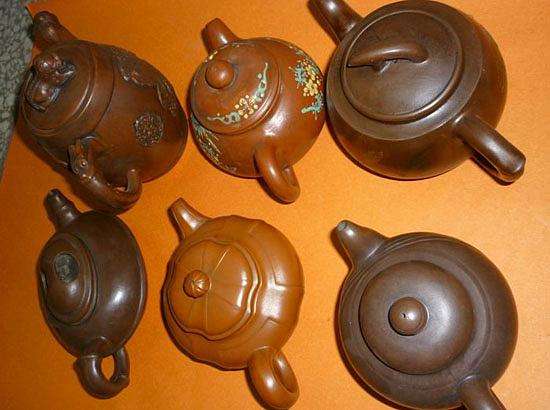In searching for artistic models, the majority of American ceramists explore the vast heritage of art with the understanding that artistic perfection can be found in any time period and any culture, thereby becoming a resource for one’s own artistic endeavors. The intent of Chinese scholars, as a case in point, was always to refine and elaborate upon established styles and techniques with the hope of attaining insights and achieving new interpretations. For example, in seeking to achieve a fuller expression in landscape painting, the scholars began to add poetry and their personal colophons to the work. The Yixing teapot, a perfect blend between the scholars' aesthetic and the skill of Yixing potters, was a manifestation of this attitude. As they saw no contradiction in art being both functional and sculptural, they first built upon the historic precedent of tea utensils arriving at a teapot, eventually carving it with landscape imagery, poetry and their personal colophons to complete the aesthetic expression.
The teapots of Yixing proved themselves to be informed, intelligent and impeccably crafted objects. From the moment they arrived in Europe, over three hundred and fifty years ago, Western ceramists have used them as models. Today European ceramists, like their American counterparts, continue to find inspiration in those works, confirming that they have withstood the test of time.
Beyond Yixing wares' form and content, my overarching thesis is that the philosophy and aesthetic sensibilities instilled within them are what contemporary American ceramists respond to. I tried to highlight what I thought were pieces of the giant puzzle that lend insight into why this is so. Here, I will venture to add that few American ceramists have a full picture of the Chinese scholars or the genesis of the teapot Ceramics is a visual art, and an objects' visual presence is what draws our attention. What I felt needed to be addressed is how many contemporary artists, as a result of their formal education in the arts, look to incorporate with their visual instinctive response an informed intellectual understanding because any real interpretation is dependent upon identifying what lies behind the work. In the end, this allows for a fuller appreciation that can open pathways to deeper meaning, the content of which can Inform, focus and lead.
As one culture has assimilated another's specific tradition, the evidence suggests the assimilation disdains mere reiteration and goes even further, establishing a conceptual bridge between past and present, people and cultures. Having been filtered through eclectic American sensibilities, a shift has been created that provides a very different interpretation. The results, I believe, are a sensitive incorporation of shared ideals with a view of our current time and place.
In the last twenty-five years, the ideals established by the scholars have also seen a reawakening among the potters of Yixing who once again have begun to exercise their artistic birthright. At the dawn of the new millennium, with China's ascent into modernity, the doors have reopened to allow Western influences to filter in. in their quest to find a balance between the dualities of past and present ideas, contemporary Yixing potters have found artistic sustenance in the American interpretations of their tradition. There is now a cross fertilization evidenced by the new forms we see produced. As each culture has an influence upon the other’s creative process, it has proven to be a boon for both. The challenge is for each artist to build upon tradition, while developing a singular and unique voice. In their detailing, their form or simply in their attitude, we see a building upon the language of art and tradition when Richard Notkin's Stacked Crates Teapot reverberates in a late twentieth-century Yixing teapot, that echoes back in Robin Campo's Chop Pot.
I hope this text has made it apparent that traditional Yixing teapots are objects that spark the imagination and enrich the deep limitless story of ceramic history, going far beyond the subjects they depict and their usage for serving tea. Being their caretaker has given me the opportunity to preserve and share their spirit Clearly, as Yixing teapots continue to inspire, contemporary American ceramics have added to the dialogue and now share a place alongside those exemplary models as objects of intellectual and artistic sophistication.



